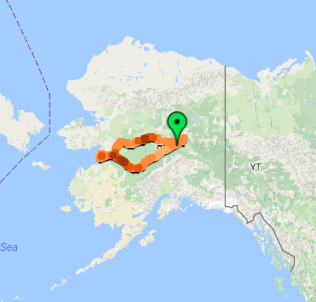The Carbon in Arctic Reservoirs Vulnerability Experiment (CARVE) is a pioneering regional study of methane and carbon dioxide emissions across Alaska and the Canadian Arctic. CARVE made frequent and sustained science flights across Alaska using NASA's Sherpa C-23B aircraft. The C-23 carried a variety of research sensors, including gas analyzers that measure methane and carbon dioxide concentrations. Flight campaigns occurred each month throughout the growing season (approx. May through November), when Arctic carbon emissions are at their highest and change most rapidly. CARVE science flights began in 2012 and continued through 2015.
Because no other program has made measurements as comprehensive and widespread as CARVE's, these measurements will serve as a baseline to determine the rate of greenhouse gas emissions as the Arctic region warms. The measurements are crucial for understanding changes in Arctic carbon cycling and the potential threats posed by thawing of Arctic permafrost.
Fly Along with CARVE over the Alaskan Arctic: Video Tour
The ORNL DAAC has released the first of many data products generated by the CARVE campaign:
This data set provides atmospheric carbon dioxide (CO2), methane (CH4), carbon monoxide (CO), ozone (O3), and water vapor (H2O) concentrations from CARVE airborne campaigns over the Alaskan and Canadian arctic. These data are merged and gap-filled outputs from two different cavity ring-down spectrometers (CRDS; Picarro Inc.) flown aboard the CARVE aircraft and are presented at 5-second intervals throughout each flight. Aircraft latitude, longitude, and altitude are also provided.
Airborne CARVE greenhouse gas concentrations from both the NOAA and Harvard Picarro CRDS instruments are also available as separate data sets:
- CARVE: L2 Atmospheric CO2, CO and CH4 Concentrations, Harvard CRDS, Alaska, 2012-2014
- CARVE: L2 Atmospheric CO2, CO and CH4 Concentrations, NOAA CRDS, Alaska, 2012-2015
A full list of CARVE data products is available at: CARVE data products
Data Acknowledgements:
Data Authors: J.W. Budney, R.Y-W. Chang, R. Commane, B.C. Daube, A. Dayalu, S.J. Dinardo, E.W. Gottlieb, A. Karion, J.O.W. Lindaas, C.E. Miller, J.B. Miller, S. Miller, M. Pender, J.V. Pittman, J. Samra, C. Sweeney, S.C. Wofsy, and B. Xiang
Data Set DOI: http://dx.doi.org/10.3334/ORNLDAAC/1402
Data center: ORNL DAAC
Sponsor: NASA EOSDIS



